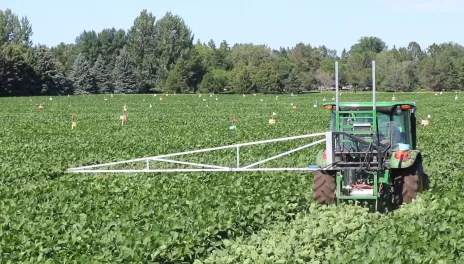NDSU Research Finds Low-cost Solutions to Crop Disease Management
Managing crop diseases can become a major expense for farmers, and ineffective management strategies often lead to significant economic losses.
Michael Wunsch, plant pathologist based at the NDSU Carrington Research Extension Center, and his team are working to find low-cost strategies for managing two major diseases – root rot in field peas and white mold in soybeans. Both are serious problems that have defied easy management.
On soybeans, Wunsch and his team evaluated many different management strategies and made significant breakthroughs in yield gains once they started evaluating fungicide application timing and spray droplet size.
“We learned that the fungicide application timing and spray droplet size generally used for white mold management in soybeans were not optimal,” says Wunsch. “Optimizing fungicide application timing relative to growth stage and canopy closure increased the yield gain from the fungicide by 50%, and calibrating fungicide droplet size relative to soybean canopy closure and nozzle manufacturer increased the yield gain by another 50% to 100%.”
On field peas, he and his team have generated promising results suggesting it may be possible to manage Fusarium and Aphanomyces root rots successfully with the combined use of early planting, fungicide seed treatment and a six-year crop rotation.
In research conducted in central and western North Dakota over multiple years, field pea yields have been increased by 4 to 8 bushels per acre with early planting, 4 to 6 bushels per acre with fungicide seed treatment, and 9 to 11 bushels per acre with a six-year crop rotation in fields with severe root rot pressure.
“None of these management strategies is sufficient when utilized alone, but the effects are additive,” says Wunsch. “We’ve achieved commercially acceptable yields by combining all three.”
The cost of implementing these management strategies in soybeans and field peas is minimal.
“In a time of surging input costs, it’s great to find low-cost solutions,” says Wunsch.
MORE INFORMATION:
Carrington REC - Plant Pathology Research Page
Michael Wunsch, 701-652-2951, michael.wunsch@ndsu.edu

